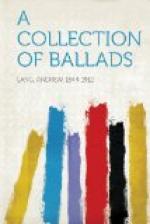Thus, in Tamlane, the whole donnee is popular. But the current version, that of Scott, is contaminated, as Scott knew, by incongruous modernisms. Burns’s version, from tradition, already localizes the events at Carterhaugh, the junction of Ettrick and Yarrow. But Burns’s version does not make the Earl of Murray father of the hero, nor the Earl of March father of the heroine. Roxburgh is the hero’s father in Burns’s variant, which is more plausible, and the modern verses do not occur. This ballad apparently owes nothing to literary romance.
In Mary Hamilton we have a notable instance of the Historical Ballad. No Marie of Mary Stuart’s suffered death for child murder.
She had no Marie Hamilton, no Marie Carmichael among her four Maries, though a lady of the latter name was at her court. But early in the reign a Frenchwoman of the queen’s was hanged, with her paramour, an apothecary, for slaying her infant. Knox mentions the fact, which is also recorded in letters from the English ambassador, uncited by Mr. Child. Knox adds that there were ballads against the Maries. Now, in March 1719, a Mary Hamilton, of Scots descent, a maid of honour of Catherine of Russia, was hanged for child murder (Child, vi. 383). It has therefore been supposed, first by Charles Kirkpatrick Sharpe long ago, later by Professor Child, and then by Mr. Courthope, that our ballad is of 1719, or later, and deals with the Russian, not the Scotch, tragedy.
To this we may reply (1) that we have no example of such a throwing back of a contemporary event, in ballads. (2) There is a version (Child, viii. 507) in which Mary Hamilton’s paramour is a “pottinger,” or apothecary, as in the real old Scotch affair. (3) The number of variants of a ballad is likely to be proportionate to its antiquity and wide distribution. Now only Sir Patrick Spens has so many widely different variants as Mary Hamilton. These could hardly have been evolved between 1719 and 1790, when Burns quotes the poem as an old ballad. (4) We have no example of a poem so much in the old ballad manner, for perhaps a hundred and fifty years before 1719. The style first degraded and then expired: compare Rob Roy and Killiecrankie, in this collection, also the ballads of Loudoun Hill, The Battle of Philiphaugh, and others much earlier than 1719. New styles of popular poetry on contemporary events as Sherriffmuir and Tranent Brae had arisen. (5) The extreme historic inaccuracy of Mary Hamilton is paralleled by that of all the ballads on real events. The mention of the Pottinger is a trace of real history which has no parallel in the Russian affair, and there is no room, says Professor Child, for the supposition that it was voluntarily inserted by reciter or copyist, to tally with the narrative in Knox’s History.




